Content
- 1 How to choose eggs to grow
- 2 What and how to feed
- 3 Broiler chicks from zero days
- 4 Weekly chicks
- 5 Chickens from 10 to 20 days
- 6 How to raise monthly chicks
- 7 Chickens 45-50 days
- 8 Breeding adult broilers at home
- 9 Correct feeding. Where to begin
- 10 Broiler chicken diseases
- 11 Features of growing broiler chickens
- 12 Feeding broiler chickens at home
- 13 Use of compound feed for broiler chickens
- 14 Features of breeding broilers at home
- 15 How to feed and vitaminize chickens
- 16 Keeping broilers at home
- 17 Transfer of young animals to the chicken coop
- 18 Top dressing and compound feed
- 19 Why broilers are bred
- 20 How to choose chicks for personal rearing
- 21 Features of growing broilers
- 22 What and how to feed broilers
- 23 Broiler rearing mistakes
Broiler is a hybrid of domestic animals, obtained by crossing different breeds. It is distinguished by its early maturity. Broilers are called not only poultry, but also other animals, such as rabbits.
In this article we will talk about broiler chicken, namely: where to start, how to choose eggs, what and how to feed according to the growth periods, how to water, what vitamins to give, what should not be fed, diseases and what to treat. Let's talk about adult broilers: living conditions, feeding and water, diseases and how to treat them.
In general, we will go through all the stages of cultivation - from eggs to the sale of the finished product.
How to choose eggs to grow
 Broiler eggs
Broiler eggs
The choice of eggs for incubation is an important part of the broiler raising process, because it determines the percentage of chicks hatching, how healthy the offspring will turn out, how often they will get sick or not at all, how quickly they will gain weight, etc. Whether you will be left at a profit or at a loss will also depend on the right choice for laying the eggs.
For selection of eggs, we select a healthy broiler chicken without signs of infectious diseases. It is recommended to leave your choice on a medium-sized hen.
The egg should be uniform in color. It is advisable to choose medium sizes, because the same offspring is obtained from small eggs.
Large ones have a thin shell. Therefore, the appearance of microscopic cracks through which they penetrate into the embryo of infection is not excluded. In addition, many eggs of this size simply will not hatch.
The weight of the egg is also selected, if possible, the same. Then the chickens are born with a slight time difference.
We take eggs from the nests several times a day. Their overheating or cooling is unacceptable. It is advisable to store them in a warm, dry room, in which the permissible temperature drops do not exceed 5 degrees.
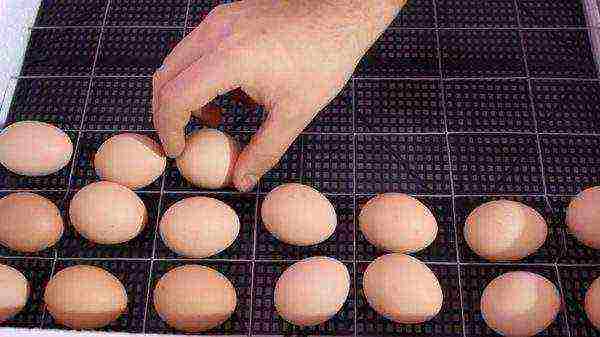 Setting eggs in the incubator
Setting eggs in the incubator
The maximum shelf life between removal from the nest and setting in the incubator is two or three days. If this period is exceeded, the likelihood of negative consequences for their healthy development in the future increases.
A correct, competent approach to the process of choosing eggs for laying them in an incubator is the key to a successful result.
The maximum age of a hen from which eggs are taken for an incubator is limited to 2 years.
What and how to feed
It is very important to feed broiler chicks correctly, starting from the first day of their life, because starting feeding sets the appropriate rate of growth and development of these poultry. In addition, the composition of the feed plays a decisive role in the quality of the final product - meat.
Broiler chicks from zero days
There is a widespread opinion that day-old broiler chickens should be immediately given chopped boiled eggs, cottage cheese, mixed feed, which help to strengthen the digestive system.
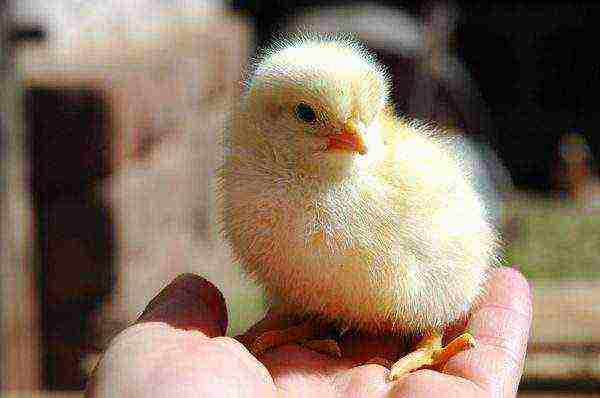 Broiler chicken
Broiler chicken
However, others caution against such a decision. They argue that this is precisely the reason for the death of the poultry population during the first 2 - 3 days of their life. And feeding broiler chickens with boiled eggs at one day of age not only does not strengthen their immunity, but also causes a disorder of the digestive system, causes a large number of deaths.
It is not recommended to give any wet food. It is useful at such an early age to give only millet and a small amount of egg powder. Chicks should have free access to feed and water. The size of the cage, box, and other place in which the brood was kept allowed each chicken to eat and drink freely. In water, we dilute potassium permanganate (potassium permanganate) in a very low concentration.
In this case, the color of the water should not be allowed to change to pink. It is also recommended to separately prepare an aqueous glucose solution. This will help avoid indigestion - a disease of the digestive tract.
The room in which the chickens are kept should be well ventilated but protected from drafts. Dampness is also detrimental to them, even if the optimum temperature is maintained.
Weekly chicks
You can gradually accustom kids to starting compound feed from the fifth day of their life. At the same time, they are soldered with a prominent solution of vitamins. Before this age, it is not recommended to give them antibiotics.
It is useful to drop "Trivitamin" into the beak of each chicken - a drug for the treatment and prevention of vitamin deficiency. Add "Baytril" to the water, which is intended against infections at the rate of 1 gram per 2 liters of water.
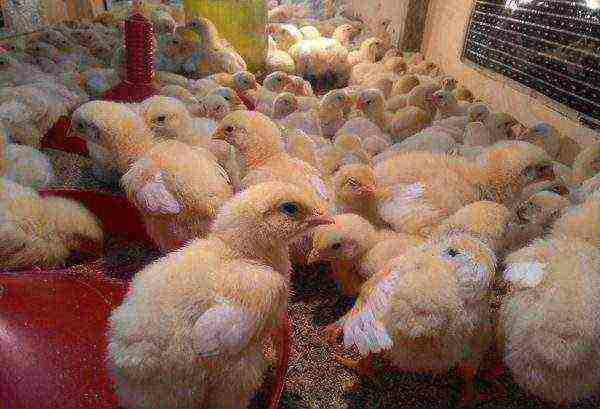 7 day old chicks
7 day old chicks
From one week of age, chickens are taught to eat cottage cheese. We vary the diet with crushed boiled egg. The feed can be slightly moistened with whey. The approximate daily consumption rate during this period reaches 15 - 20 grams. Indoor temperature - 30 - 32 degrees.
Important! Make sure the chickens do not get dirty or wet while eating. Otherwise, it is fraught with their death. The places where they are kept must be dry with the required temperature and humidity.
Chickens from 10 to 20 days
During this period, greens are added to the porridge (slightly moistened dry starter food), for example, finely chopped onions, at the rate of 1:20. It contains the necessary vitamins. Besides, green onions are used as an antiparasitic agent.
To avoid one of the most common diseases of poultry - coccidosis, which leads to disruption of digestion and dehydration of the body, at two weeks of age, add the drug Baycox to the water at the rate of 1 gram per 2 liters of water.
During this period, they eat feed up to 30 grams per day. In order for babies to have a good growth, take care of an increased daylight from the first days. The ambient temperature is kept at a level not lower than 28 degrees. If young animals at this age are overcooled, they can get bronchopneumonia, which occurs precisely as a result of hypothermia.
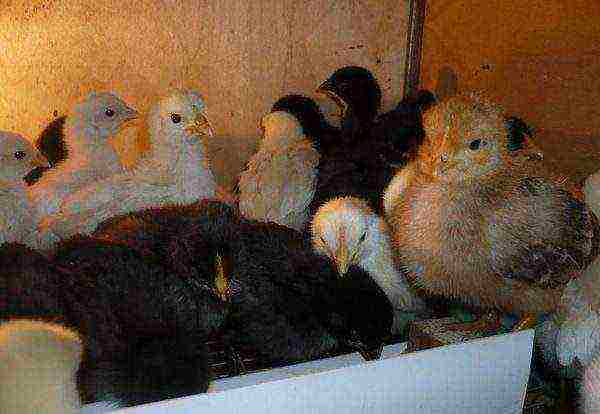 Two week old young
Two week old young
You can add reverse, yogurt, buttermilk to the feed. After 15 days of feeding, protein feed of plant origin is mixed into the food. The proportion of greenery can be gradually increased. It should now account for up to 10% of the total feed weight.
Stir in crushed eggshells, feed yeast, and grated carrots in small amounts. In no case should sand be given to chickens. Do not forget to make a very weak solution of potassium permanganate.
From day 10 for three or four days, broilers may begin to die. Therefore, during this period, we solder poultry with antibiotics. Add a couple of drops of iodine. After a short break, vitamins are given, vitamin D is especially important during this period for rickets.
Lack of vitamins leads to hypovitaminosis A, D, E, B. Chickens are given only high-quality feed. If you buy it ready-made in a package, keep an eye on the expiration dates.
Juveniles should be kept away from adults to avoid disease transmission. Chicks up to 20 days old require round-the-clock lighting.
How to raise monthly chicks
After 22-25 days, they switch from feeding with starting compound feed (cereals) to growing (in granules). The composition of the broiler feed should include mineral content, protein (fish meal), cereals (corn), amino acids and vitamins. You can also continue to add green mass.
To save money we advise do not buy expensive growth food, but make its composition yourself: crushed wheat, oats, corn, barley, peas. All components are mixed in equal proportions. It is advisable to add fish oil, whey, meat and bone meal to the feed. Add (but do not mix) the leaves of cabbage, lettuce, green onions.
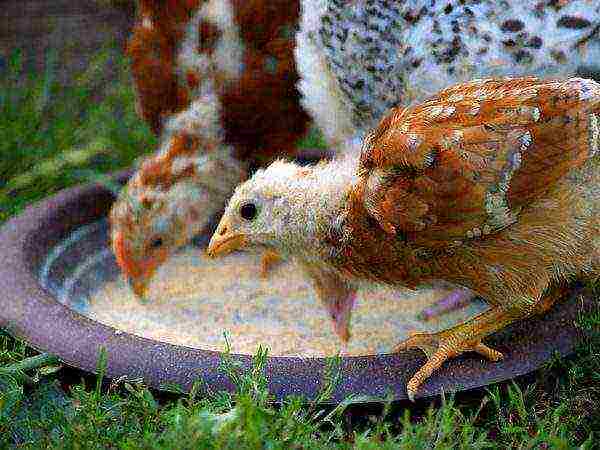 Feeding one month old chicks
Feeding one month old chicks
By 35 days of age, you can gradually increase the amount of corn to 40% of the total, and reduce the amount of wheat, oats and barley. The meal or cake is about 15%. The percentage of green mass can be reduced.
Under normal conditions and quality feeding, monthly chicks weigh about 800 grams.
We exclude from the diet all types of bread, boiled potatoes (if it does not go in a mixture with other components), all stitched products, especially if you smell. We remind you to refrain from adding sand. We make sure that the water of the chickens is constantly clean, fresh, slightly warm. It is useful to use settled water.
We lower the temperature of the medium to 23 - 25 degrees. The duration of lighting is reduced to 14-16 hours a day.
To avoid aspergillosis at this age, you need to ventilate the room well, avoid dampness. For prophylaxis, add a little iodine-containing preparations to feed and water.
All new feeds are given in small quantities at first so that the chicks can get used to it. Otherwise, they may have indigestion, which will lead to death.
Chickens 45-50 days
After 40 days of life, the young are given not crushed, but whole grain. A commercially available finishing compound feed containing the main nutrients is also used. But if you want to have tasty meat, you can refuse to purchase it.
Whole grain is poured into the feeders, not crushed grain. Vitamins, feed yeast, chalk must also be present in the feed. After reaching 45 days of age, we exclude any medications. A good effect is given by cooking porridge, which includes boiled small fish, corn, wheat, peas, greens.
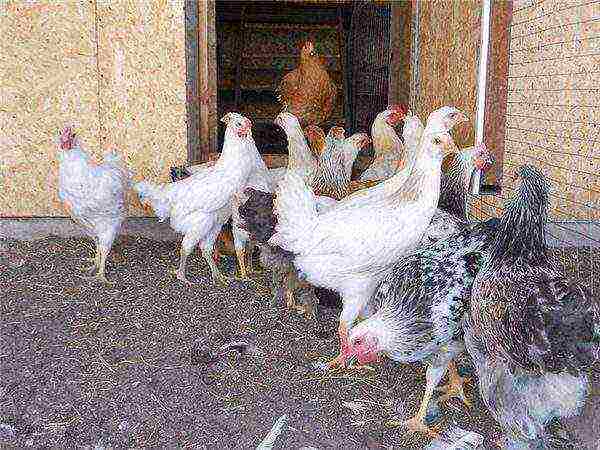 2 month old broilers
2 month old broilers
All this is mixed and allowed to brew. In porridge, we increase the percentage of corn to half of the total mass.
If you did not save on feed and gave a complete diet, their weight at this age should be more than one kilogram. The breed also has a big influence on this figure.
If the weight of a unit of young animals of one breed reaches 1, 2 - 1.3 kg, then the weight of a grown chick of this age can be 1.6 - 1.8 kg. all other things being equal.
We continue to use clean settled water. We gradually lower the ambient temperature to 21 - 23 degrees. The duration of daily lighting is reduced to 12-14 hours.
The area in which the young are kept should be sufficient so that everyone can freely approach the feeder or drinker. However, the walk should not be spacious, otherwise the broiler will lose weight due to excessive activity.
Breeding adult broilers at home
Keeping broilers for fattening for more than two months is not economically feasible, as the birds gain weight more slowly with age and feed more. In addition, broiler meat older than 70-75 days is less tasty than two months old.
Cell maintenance and care at home
If you want to raise up to 10 head of chicken broilers at home, their cage content will suit you. Depending on the size of the cage, they contain 3-5 heads (then the size of the cage is made from such a calculation in order to limit the free movement of the bird to the required one - to go to the feeder and drinker), or up to 10 heads (the size of the cage increases, the requirements for the spatial conditions of detention and the dilutions remain the same).
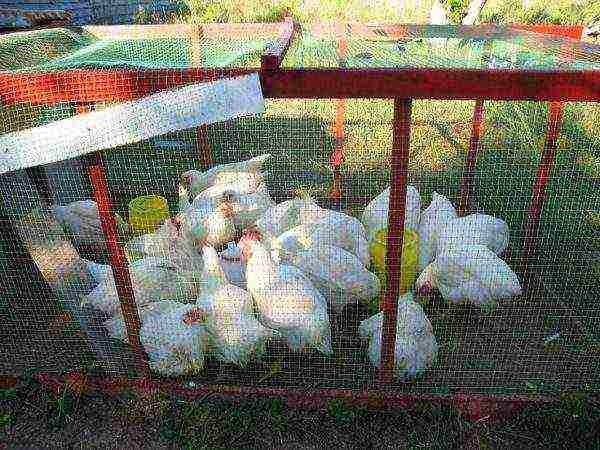 Keeping birds in a cage
Keeping birds in a cage
When growing livestock more than 10 units need to do or additional number of cells (since one cage, with more than a dozen heads in it, is very cumbersome and inconvenient to move, it loses mobility), or think about keeping in a pen.
Let's say that it is economically beneficial for you to breed livestock in cages. Then, for dry food (mixed fodder, grain), it is advisable to choose trough-type feeders, which are placed outside the cages along a whole tier. We also build a continuous drinking bowl, for example, from a PVC sewer pipe.
The front side of the trough can be made from metal rods of the combined type. This is convenient because chickens can be kept in such a cage at first.
Steel rods on the walls are placed among themselves quite often so that the brood does not run out of the cage or fall out of it (if the cage is in the second or third tier).
After the young grows up, they are seated in different cages, removing the rods from the walls through one. Thus, we provide free access to feed for an adult broiler.
How to grow: tips for beginners
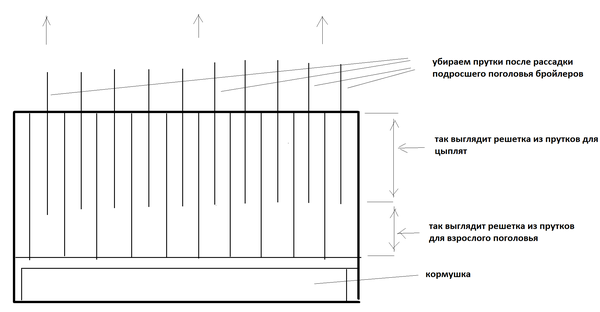 Broiler cage
Broiler cage
There are several requirements for the conditions of keeping an adult broiler bird:
- so that the content area makes it possible eat freely each individual, that is, not too small, but not too large (the reasons are indicated above);
- permanent availability of high-quality fresh feed in the feeders. In addition, there can and should be separate feeders for porridge, if used;
- constant availability of fresh (better settled) warm water in drinking bowls, but not higher than 22-25 degrees;
- enough hours daylight hours (12-14 hours). If less - we give additional lighting;
- humidity air 68-72%;
- no dampnessespecially in cells;
- no drafts must not be;
- ambient temperature - within 20-21 degrees (if it is lower, then the activity of broilers decreases, the intensity of feed consumption decreases, the growth of mass slows down; if it is higher, then the bird becomes hot, the result is the same);
- obligatory presence ventilation, since otherwise the intensive accumulation of nitrogen has a detrimental effect on the vital activity of the bird. A case is described when the owner, in order to save on heating, placed the floor of a hundred broilers in a greenhouse where greens were grown in a small makeshift paddock. Despite the fact that the greenhouse was periodically supplied with fresh air, after a few days the greens began to fade due to the increased nitrogen content in the air, although this was not felt. After the corral was fenced off with foil, the concentration of nitrogen in the environment in the corral reached such a level that the chickens began to behave sluggishly, ate feed reluctantly, and slowly gained weight.
- cells inside must be clean... To do this, you can make the floor from a galvanized welded fine mesh, and clean the floor pallet based on the amount of droppings accumulated in it;
- if growing broilers at home is "put" on stream, then it is necessary to periodically carry out disinfection of cells (after the slaughter of the previous batch, but before growing the second).
Disadvantages of keeping birds in cages:
- requires monetary investments more than with a driven cultivation method.
Advantages:
- more convenient in service;
- more compact (saves used space).
How to keep and raise a broiler in a pen
This method of keeping broilers and chickens from zero days does not differ from the previous one. The main differences are as follows:
- economically viable in terms of construction. Basically, to raise birds in a pen you need a floor and walls. If you are going to raise a bird in a barn, then part of the barn is fenced off with collapsible sections made of welded mesh wire, put feeders and drinkers - and the pen is ready;
- designed for content not less than 10 heads birds;
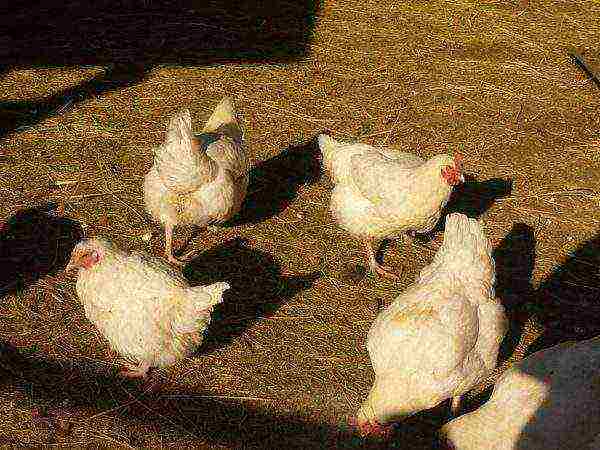 Walking hens in the corral
Walking hens in the corral
Flaws:
- requires increased care and attention to elimination of dampness and high humidity, you need to frequently change the litter of broilers to keep the floor dry;
- by area occupies more space per one livestock unit.
Advantages:
- less material costs, compared to the first method.
Requirements for ambient temperature, humidity, absence of drafts, dampness and other conditions of detention remain the same.
Correct feeding. Where to begin
As mentioned above, it makes no sense to fatten broilers for more than two months. This is justified by the following:
- after two months fattening poultry gains weight more slowly;
- consumption feed increases;
- broiler meat older than 2.5 months tougherless tasty.
Feeding adult broilers (in our case, in the recommended age range from 60 to 75 days) comes down to the fact that they need to be given only high-quality feed with the following diet:
We feed adult broilers with whole grain or purchased final compound feed. To make the meat tastier, we advise you to abandon the purchased compound feed altogether. This will save you money and improve product quality.
But even more worries will be added, in order to breed chickens, you will need to buy separately grain of wheat, barley, corn, peas, etc., mix all this in proportions. Do not forget to give greens, add fishmeal.
If you are not lazy, then prepare porridge for your poultry from the above ingredients with the addition of cooked small fish. If there is no fish, add fish oil. The main specific gravity should be maize (up to 50%).
Some, when growing poultry, after two months of feeding, switch exclusively to corn and greens (5-10 days before slaughter). For normal chain feeding, expect your broilers to weigh at least two kilograms by 70 to 75 days of feeding.
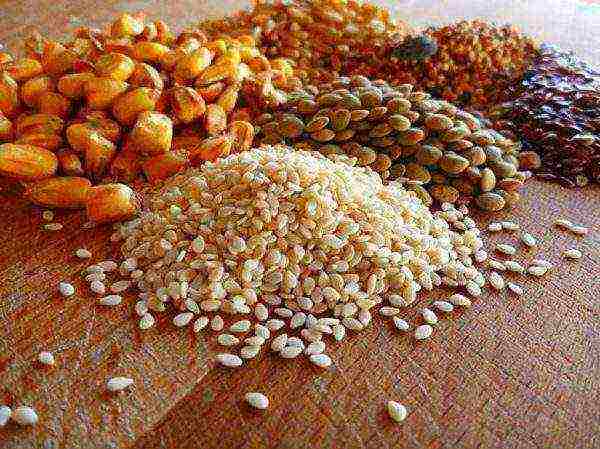 Broiler feed
Broiler feed
Attention! We do not give broilers:
- boiled potato (if it does not go in a mixture with other components);
- all varieties of bread;
- all overdue products;
- sand;
- medications (if possible);
- several new products food in large quantities;
- other components, if we see what they call negative reaction the bird.
What to drink
Follow the same rules as for raising young stock. The water should be:
- clean, preferably separated;
- moderately warm (in the region of 20 - 21 degrees);
- in drinking bowls, providing unimpeded access poultry (depends on the number of livestock);
- can be diluted at very low concentrations potassium permanganate (potassium permanganate). In this case, the color of the water must not be allowed to change to pink.
Broiler chicken diseases
Broiler chickens can be sick with quite a few diseases. Some of them:
- heterokydosis - worms in the intestines. Piperazine can be used against this disease. Preventive measures - thoroughly wash the room in which the chickens are;
- arthritis - joints of chickens suffer (broilers walk less, try to sit down). Ampicillin (10 mg per 5 kg chicken weight) can be used for 5 consecutive days.
 Ampicillin for arthritis
Ampicillin for arthritis
Arthritis prevention measures: Provide only quality food, bedding should be dry;
- ascites (accumulates fat in the abdomen). The bird walks sluggishly and reluctantly. To avoid this disease, it is necessary to give greens;
- salmonellosis manifests itself in upset stomach... Can be treated with tetracycline or dithrevite. The dosage is indicated in the instructions for these medicinal products;
- pseudo-plague - chickens can become infected through contaminated eggshells. It is necessary to plant the sick and disinfect the room;
- simple poisoning... To avoid this, you need to ensure that the food is fresh and of high quality, and that foreign objects, such as fish bones, do not fall into the feeders).
If you do everything right, the result will not be long in coming.
Recommendation for beginners: there is nothing better than personal experience... Therefore, in the initial stages of your business development, you can use the information and recommendations of others. But if in practice you achieve the best results thanks to your best practices, it is a sin not to take advantage of this.
If you find that some recommendation does not apply to the growing conditions of broiler chickens in your conditions, think for yourself how to get out of the situation to achieve optimal results.
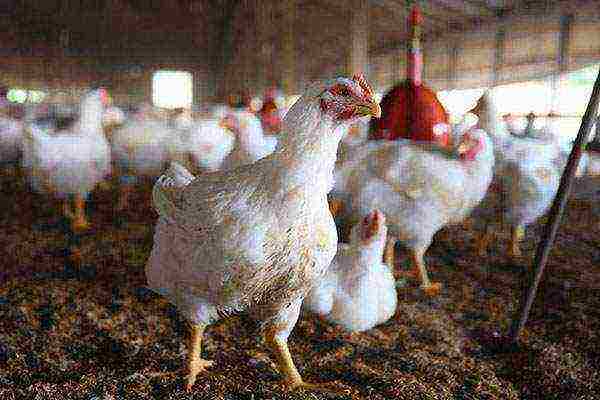 Speaking of broilers, we mean meat-based chickens, characterized by high growth rates, large size and excellent meat suitable for frying.
Speaking of broilers, we mean meat-based chickens, characterized by high growth rates, large size and excellent meat suitable for frying.
An increasing number of poultry farmers are interested in how to organize the raising, care and feeding of broiler chickens. And this is not surprising at all.
In just 7–8 weeks, the bird grows to 1.5–2.5 kg, which, with the right approach, during the warm season, even in a small farm, makes it possible to grow 1–2 batches of chickens.
Features of growing broiler chickens
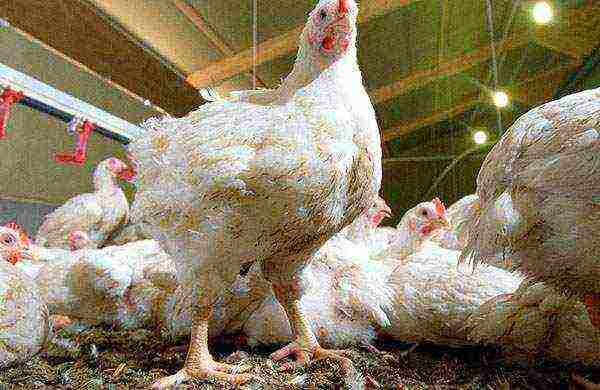 In order for chickens of broiler breeds and crosses to live up to their purpose, they need competent care and a carefully selected diet. If the bird will not be used for procreation, then raising broiler chickens at home usually takes no longer than 70 days. Then, the increase in body weight in the bird physiologically decreases, but feed consumption remains at the same level, which means that the benefit from such a livestock drops sharply.
In order for chickens of broiler breeds and crosses to live up to their purpose, they need competent care and a carefully selected diet. If the bird will not be used for procreation, then raising broiler chickens at home usually takes no longer than 70 days. Then, the increase in body weight in the bird physiologically decreases, but feed consumption remains at the same level, which means that the benefit from such a livestock drops sharply.
When raising broiler chickens, the poultry farmer focuses on the care and feeding of the poultry. Both must be adjusted from the first day of the chicks' stay on the farm, since delay often becomes the cause, if not death, then the weakening, stunting and sickness of the livestock.
In a backyard farm, broilers are settled in poultry houses on deep litter or cage keeping is used.
In the first case, the broiler room should be protected from external weather factors, and the floors should be warm and dry. It is most convenient to use sawdust as a bedding, which is well dried beforehand. You can use other materials to ensure that the flooring is always dry, clean and loose.
Before settling chicks:
- cleaning, disinfection and drying of the poultry house;
- the floor is covered with a layer of slaked lime at the rate of 0.5–1.0 kg per square meter;
- on top of it, sawdust is poured with a layer of up to 10 cm;
- create conditions for maintaining air humidity at the level of 60–65%;
- provide constant ventilation of the room;
- maintain an air temperature of 26 ° C;
- provide round-the-clock lighting for day-old chicks.
With this method of growing broiler chickens, there should be no more than 12-18 birds per square meter.
While broilers are small and their own thermoregulation is imperfect, they need an elevated air temperature of 26–33 ° C. After 20 days, the air in the house can be cooled to 18–19 ° C. At the same time, it is important to ensure that the bird is comfortable, otherwise both too cold and excessively warm air negatively affects the growth and well-being of the chicks. Neglect of the rules for keeping poultry threatens to become familiar with the symptoms of diseases of broiler chickens and the treatment of a poorly growing flock.
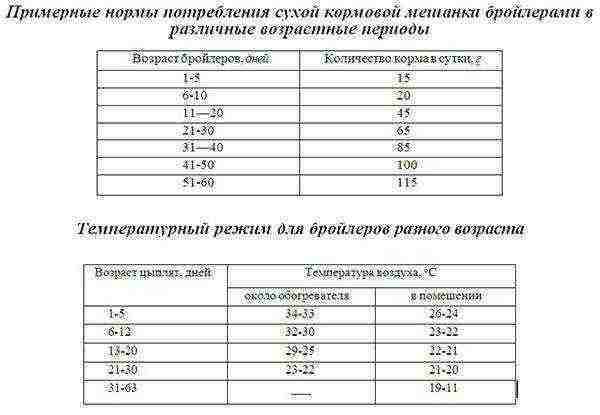 Growing in cages, especially of a multi-tiered structure, can significantly save the area of the poultry house, simplify its hygienic processing and control the feeding of chicks. At the same time, the temperature and humidity conditions, as well as the average daily feed consumption rates, are similar to the content on the litter.
Growing in cages, especially of a multi-tiered structure, can significantly save the area of the poultry house, simplify its hygienic processing and control the feeding of chicks. At the same time, the temperature and humidity conditions, as well as the average daily feed consumption rates, are similar to the content on the litter.
The rearing, care and feeding of broiler chicks is greatly influenced by the lighting of the cages or house. During daylight hours, the bird actively feeds and moves. The darker the room, the more sluggish the chicks grow.
Therefore, within 14 days from the moment of birth, round-the-clock lighting is organized for the chicks, and then they gradually switch to the natural regime.
Feeding broiler chickens at home
 However, it is not enough to create suitable conditions for the chickens and provide them with the proper amount of feed. To get large, well-fed poultry as soon as possible, it is important to choose a balanced, age-oriented diet.
However, it is not enough to create suitable conditions for the chickens and provide them with the proper amount of feed. To get large, well-fed poultry as soon as possible, it is important to choose a balanced, age-oriented diet.
How to feed broiler chickens? This question is most relevant for all beginner and experienced poultry farmers who have not previously encountered the cultivation of such a bird. In household plots, they often practice the use of wet and dry food of their own preparation.
The first weeks of the chicks' stay in the courtyard, they are fed with wet mash on the basis of boiled eggs, millet, crushed oats and wheat, which make up slightly more than half of the total amount of feed consumed. From 3 weeks of age, boiled potatoes are introduced into the menu, replacing them with no more than a fifth of the cereals.
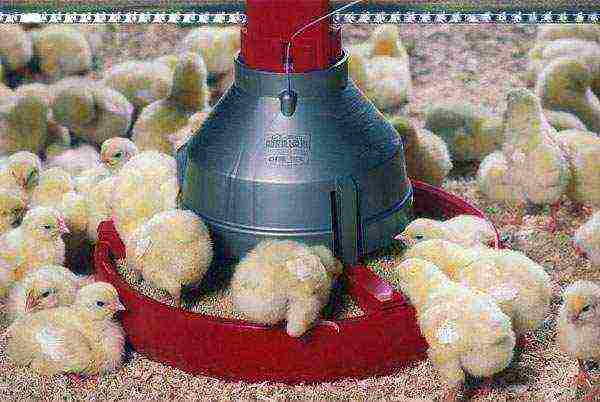 We must not forget about protein feeds, which lay the active growth of muscle and bone mass. For this purpose, the bird is given cottage cheese, yogurt, reverse and other dairy products. Fish and meat and bone meal becomes a source of animal protein from 10 days of age. These products should be given at first 5-7 grams per day per head, and then double the consumption.
We must not forget about protein feeds, which lay the active growth of muscle and bone mass. For this purpose, the bird is given cottage cheese, yogurt, reverse and other dairy products. Fish and meat and bone meal becomes a source of animal protein from 10 days of age. These products should be given at first 5-7 grams per day per head, and then double the consumption.
Feeding broiler chickens at home involves the use of protein-rich plant products, including sunflower cake, all kinds of meal, crushed legume seeds.
 From three days of age, green feed for broiler chickens is needed. In spring and summer, it is juicy grass, tops of garden crops, chopped carrots, 3-5 grams per chicken. In the cold period, when there is not enough fresh herbs, grass flour no more than 2–5 grams and sprouts of barley or other cereals are introduced into the diet.
From three days of age, green feed for broiler chickens is needed. In spring and summer, it is juicy grass, tops of garden crops, chopped carrots, 3-5 grams per chicken. In the cold period, when there is not enough fresh herbs, grass flour no more than 2–5 grams and sprouts of barley or other cereals are introduced into the diet.
An excess of grass meal in the feed can cause diarrhea in broiler chickens, the treatment of which implies a mandatory correction of the menu, the use of antibiotics and other drugs.
To prevent digestive problems, broilers are given:
- every other day, as a drink, a pink solution of potassium permanganate;
- fine gravel with a diameter of no more than 5 mm, which activates the intestines and improves the digestion of grain and other feed for broiler chickens.
From 5 days, the bird is given a crushed shell, but not sand, and chalk at the rate of 2-3 grams per chick. Mineral feed and gravel are not mixed with other components of the diet and are poured into separate containers that are constantly in the house.
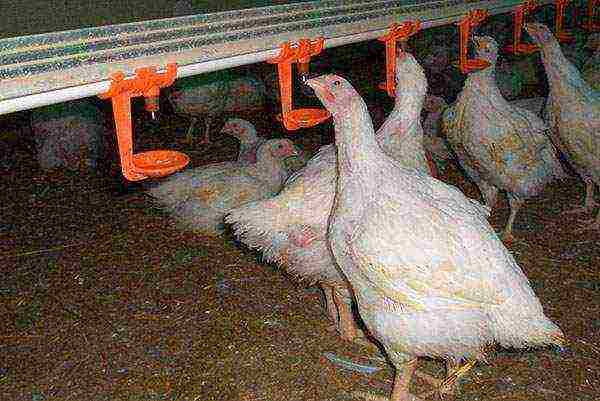 Clean water at room temperature should be maintained at all times in the house. To exclude the development of pathogenic flora and the development of intestinal and other infections, the dishes are regularly washed and disinfected.
Clean water at room temperature should be maintained at all times in the house. To exclude the development of pathogenic flora and the development of intestinal and other infections, the dishes are regularly washed and disinfected.
For better growth and as a preventive measure, at the first symptoms and treatment of diseases of broiler chickens, young chickens are given vitamin supplements. Already from the fifth day on the menu, they practice the use of oil solutions of vitamins A, D, and E, preventing an overdose of the drugs used.
 How many times a day and how to feed broiler chicks at home? The bird should not be deficient in food throughout its life. For the first 7 days, chicks should receive feed at least 8 times a day, then the bird is fed every four hours. In the third week, the number of meals is brought to four, and from the age of one month, broilers are fed in the morning and evening.
How many times a day and how to feed broiler chicks at home? The bird should not be deficient in food throughout its life. For the first 7 days, chicks should receive feed at least 8 times a day, then the bird is fed every four hours. In the third week, the number of meals is brought to four, and from the age of one month, broilers are fed in the morning and evening.
All wet broiler chicken feed is prepared so that the bird will eat it within 30-40 minutes.
If the mash is kept warm longer, it is possible:
- souring of products;
- insemination of them with insect eggs;
- development of pathogenic microflora.
All these factors are most often the cause of diarrhea in broiler chickens, the treatment of which weakens the population and slows down the growth rate.
Use of compound feed for broiler chickens
 To intensify weight gain, today they use ready-made and home-made feeds that fully meet the physiological needs of the bird. This diet gives especially good results in the first four weeks.
To intensify weight gain, today they use ready-made and home-made feeds that fully meet the physiological needs of the bird. This diet gives especially good results in the first four weeks.
Finished broiler chicken feeds vary in particle size and composition. Most often, they resort to a three-stage feed system, which is designed for all ages of chickens from birth to slaughter.
Although these mixes are more expensive than homemade mash, they significantly improve the performance of the growing stock, make it easier to care for, raise and feed broiler chicks, and control food intake.
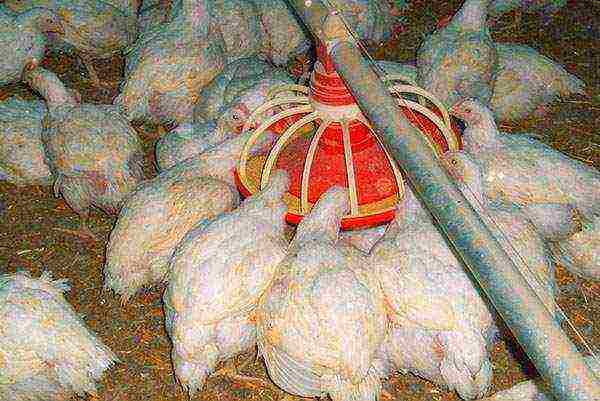 At the initial stage, compound feed helps to strengthen the immune system, create all the prerequisites for good health and rapid growth of the bird. For this purpose, the amount of mineral supplements in the diet increases, the diet is based on easily arranged components.
At the initial stage, compound feed helps to strengthen the immune system, create all the prerequisites for good health and rapid growth of the bird. For this purpose, the amount of mineral supplements in the diet increases, the diet is based on easily arranged components.
During active growth, broiler chicken feed is a source of protein, calcium, vitamins and fats, ensuring rapid bone growth and muscle growth. Before slaughter, finishing mixtures are used to increase body condition.
Growing broiler chickens in cages - video
Part 1
Part 2
Part 3
Part 4
Part 5
Part 6

Foreword
Broilers at home grow as fast as in poultry farms, but only if certain rules are followed. All you need for breeding is a dry, clean room, plenty of feed and a little patience. When buying chickens, the question arises: take one-day cheap smokers or two-week ones. The older the chicks are, the better, but they are also more expensive.
Features of breeding broilers at home
And now, the long-awaited moment has come. You brought home a box of little squeaky yellow lumps. Have you already prepared a place for them? If they took smokers in March or April, then first you have to keep them in the house. First, let's build a house. We connect two cardboard boxes together, fastening them with wire on the sides, and cut a hole - the entrance. The first box will be for kids' bedrooms, the second will be a kitchen and a place for walking. Chickens should always have warm feet. It is undesirable to put boxes on a cold floor. We'll put the house either on foam plastic or on an old carpet. A cloth mat is placed in the box, which needs to be shaken out and dried daily.
A light bulb with a cone-shaped dome is hung over the “bedroom” so that the light does not scatter, but shines into the house. Do not hang huge white and red 250 W lamps - the bird will be hot. Newborn chickens do not yet regulate their body temperature and may overheat. A 25-40 W light bulb will be sufficient. For the first 10 days, we leave the light on for the night. Then we reduce the daylight hours to 16 hours.
When illuminated with green and blue lamps, the bird gives more growth.
If the floors are warm, then you can fence off the corner for the young animals with the help of boards. To achieve the desired temperature, a heater is installed. Arrange feeders and drinkers.
How to feed and vitaminize chickens
As soon as the chickens were brought home, they need to be drunk with sweet water: a teaspoon of sugar is diluted in 1 liter of water. Then the chickens are given a boiled egg.
To keep broilers at home, you need to provide them with complete feed. The ration in the first week consists of a wet mash and dry starter compound feed. Add a boiled chicken egg, millet crumbly unsalted porridge cooked in water, cake and poultry feed to the mash. Instead of water, it is better to give a decoction of onion husks and pine needles, reverse (milk after separation, that is, skimming).
We put the feeders and drinkers in the second box. Drinking bowls, not lids with water. Some baby will get wet, and this is destructive for him.
From ten days of age, fish is introduced into the diet. Blue whiting, any fish waste will do. The fish is boiled whole and rolled through a meat grinder along with the bones. The ground fish is mixed with mixed feed and distributed to the chicks. Food should always be present in the feeders, but not sour.
It is better to give small chickens a little food. Pecked, add more. Feeders need to be cleaned and rinsed daily with a solution of potassium permanganate. When the chicks eat, we carefully look to see if there is enough food for everyone, if everyone approaches the feeder. Bone meal and shells are also added to the diet. You can give ground eggshells, roasted in the oven.
As soon as greens appear on the street, we immediately introduce finely chopped greens, nettles into the diet. We begin to give greens little by little. If there is cottage cheese, then we give it too. From ticks and fleas, dust the chickens with ash, which has lain for at least 2 months. If there is no stale ash, then press it. It will be useful to you: then put a trough with ashes in the hen house.
It is impossible to grow meat chickens at home without vitamin supplements.
- Immediately the next day, when they brought them home, we give them enrofloxacin in the morning at the rate of 1 cube per liter of boiled chilled water. This antibiotic is given for the prevention of infectious diseases. We drink for 3 days each time with a fresh solution. Instead of an expensive antibiotic for 3 days in the evening, you can drip 1 drop of vodka on each chick.
- For 3 days, every morning and evening, they moisten their feet, smoke with vodka, immersing their feet in a bowl.
- The next 3 days give a solution of ascorbic acid. Vitamin C stimulates the immune system and improves the digestion process. The contents of the package must be dissolved in 3 liters of water and given 1 liter per day.
- On the 7th day, they begin to give biovit and chiktonik. Biovit is given with feed 1 teaspoon for 50 heads 1 time per day for 1-2 weeks. Biovit is given for the prevention of hypovitaminosis and as a growth stimulant. Chiktonik is a feed vitamin supplement. It is given at the rate of 1 cube per 1 liter of water for 10 days.
- On day 14, Baycox's solution is given at the rate of 1 cube per 1 liter of water.
With this treatment, about 90 birds out of 100 grow strong and after 4-5 months they can reach weight: chickens 3-4 kg, males 4-5 kg.
Keeping broilers at home
Content temperature:
- in the first week is 33 0С;
- in the second - 30 0С;
- in the third - 28 0С;
- in the next - 20-24 0С.
Broilers at home gain weight quickly. The cardboard house will have to be expanded, because it is still cold outside, and they need more space. Every night, you need to get up and lightly stir up the sleeping young. This must be done so that the kids are not crowded and do not choke.
Chickens are prone to pecking. Most often they hammer in the head. The wounded bird is seated separately. The wound is smeared with brilliant green. If the baby is immediately planted with others, then curious individuals will begin to hammer the green crown. Pecking indicates insufficient nutrient feed.Improve the quality of feed, introduce bone and meat meal, feed yeast, herbs, grated carrots.
Plumage begins at the age of two weeks - the most difficult period in the life of a hen. It is important to provide the bird with all the necessary vitamins, be sure to include fish in the diet.
Transfer of young animals to the chicken coop
It's time to move the young to a permanent place - in the chicken coop. Breeding meat chickens requires constant cleanliness. The coop is cleaned and whitewashed. Sawdust is placed on the floor, which is regularly poured. The excrement is mixed with sawdust and re-heated with the release of heat, forming a warm litter.
The feeders are washed with potassium permanganate and dried. The walking area must be clean. They put a trough with a shell, sand and ash for bathing. Birds should not use the feeder handle as a roost or excrement may enter the feed. The handle must be revolving.
Not all owners have a brand new block barn. Often, cracks in an old wooden shed are plugged with rags. Before the introduction of young animals, we remove all the rags. Curious birds love to poke their nose, or rather their beak, where they don't need to. the chicken can get tangled in the thread with its paw or even with its tongue. Potato nets are especially dangerous.
Top dressing and compound feed
Poultry food is expensive to buy for teenagers. They eat a lot of it. We have to switch to conventional feed or ground grain. You can prepare the compound feed yourself by mixing crushed barley, peas, corn. In the morning, the compound feed is brewed with boiling water and mixed with a stick until it swells. The cooled mash is distributed to the young. Dry food in the troughs and water should be constant. Once a week, chickens are given a barely pink solution of potassium permanganate.
A two-month-old chicken weighs 1300-1500 g and is theoretically ready for slaughter. But I want to grow a huge carcass and break all records. The broiler is a bird responsive to good nutrition. It is better to plant only cockerels from chickens at the first signs of a manifestation of love. Heavy cocks leave wounds and scars on the backs of their friends with their claws. Agree, it is unpleasant to eat a skin with traces of love pleasures neither for you, nor for your guests, and maybe even for customers. By the way, the egg production of chickens also decreases.
Meat chickens lay eggs, very nutritious and delicious.
The perches in the barn should be low. The bird can manage to climb a high perch, but falls from it at night and is crippled.
Often the largest broilers sit on their feet. The cause may be a lack of vitamins. The skeleton needs calcium. Nest the chick and give him more vitamins. Alas, he will not get up on his feet, the joints of his legs are quickly turned inside out.
Rate the article:
(18 votes, average: 4.3 out of 5)
Growing broiler chickens - today this activity is of growing interest among owners of private farms, country houses and even country houses. This enterprise is considered profitable - you can slaughter broilers for meat as early as two months of age. This means that even during the summer cottage you can grow chickens weighing about one and a half to two kilograms. Cooking with a broiler is better than with regular chickens. Its meat is dietary, has a delicate texture and excellent taste.
Broiler chickens rearing, care and feeding
Why broilers are bred
Hybrid breeds of meat chickens that differ from others in their high growth rates, vigorous development and rapid accumulation of meat are called broilers. The main benefit of keeping them, in addition to rapid growth and weight gain, is the low cost of feed per kilogram of growth, in comparison with the young stock of other poultry.
The name "broiler" is a tracing paper from the English "broil", which means - to cook on a fire by frying.Immediately there are associations with tender juicy chicken fried on a spit. Broilers are called all young roosters and chickens, which are raised specifically for slaughter for meat.
Broiler breeding contains two fundamentally important points:
- meat ripeness;
- egg production rate.
With meat, everything is clear - it is taken from young animals. High egg production is necessary for the reproduction of broiler breeds. Those chickens that will reproduce offspring are raised to adulthood. They are not suitable for slaughter, but must be well laid so that new broilers can hatch from the eggs.
Raising broiler chickens in cages
Who are crosses and what are they for?
Cross is a line of chickens bred specifically for certain inherent properties. Until the active selection of domestic chickens, carried out by specialists, began, no one conducted a special selection of chickens in terms of productivity or increasing the meat mass. Today, pure breeds of chickens are bred only in private farms. In large factories, cross-hybrids with the highest productivity are grown.
Crosses are a multi-breed cross that is specially adapted for growing in artificial conditions and a controlled environment. Therefore, they are grown in poultry farms and large farms, in poultry houses, under certain predetermined modes.
Poultry farms mainly breed crosses
Meat breeds of crosses are suitable for obtaining good meat broilers in household conditions.
| "Dominant", | "Adler" |
| Ross | "Jubilee" |
| "Tetra" | "Silvery" |
| "Change" | Rodailanp |
| "Tibro" | "Kuchinskie" |
| Avian Farms | "Plymouth Rock" |
| Lohmann. | The quality of the meat of hybrids is lower than that of pure breeds. |
| Imported: | |
| "Cobb 500", | |
| "ROSS-308". | |
General characteristics of broilers
- Body sizes are larger than that of regular chickens
- The weight is high - up to 4.5 kg in an adult chicken and up to 5.5 kg in an adult rooster.
- The body is tightly knit, compact, horizontal.
- Egg production is low, but the incubation instinct is well developed.
- Temperament is calm.
- Short wings and legs.
- Rapid build-up of muscle and meat mass.
How to choose chicks for personal rearing
It is advisable to buy chicks from breeders who specially raise them for sale in accordance with all the rules and regulations. The second option is to purchase both at poultry farms and at incubator stations. In both the first and second cases, you need to be careful and clearly understand for what purposes young animals are purchased, that is, which of the two indicators is more important - obtaining eggs or meat.
Choosing chicks for personal rearing
Important!
There are no universal hybrids that equally quickly build muscle mass and regularly lay eggs in nature. If an unscrupulous chicken seller assures you of this, you shouldn't buy from him. In laying hens, the meat will turn out to be sinewy, and the meat ripeness will not come earlier than in six months. Meat broilers will not produce the expected number of eggs, but by the age of two months they will gain two kilograms of mass.
At what age should you buy chickens
This question is quite important as many producers sell day old chicks at bargain prices. Such chicks are very difficult to grow to a safe age without special incubation conditions. Most likely, they will die. The first seven to ten days of life of chickens are characterized by the maximum mortality. Therefore, it is best to buy ten-day-old chicks.
Rooster or hen
For meat broilers, this does not really matter, but if you want to choose, then you can find out the gender at chick age by the wings. Spread out your wing. A rooster will have feathers of the same size, while a hen will have different lengths. Regardless of gender, it is necessary to choose chickens that are mobile, active, with shiny, unclouded eyes.If the chicken is weak, it sits all the time, and its eyes are cloudy, it is sick and will not live long
A healthy chicken has a soft tummy, not swollen, tucked up. The down is uniform, the wings in a calm state are not spread out, but tightly pressed to the body.
Healthy chicks respond well to sound. If you knock on the box or box in which they are housed, they will rush to the source of the noise.
How to tell a rooster from a chicken at an early age
Features of growing broilers
Depending on the conditions that the owner of the private farm can provide for his feathered pets, there are two methods of keeping broilers - extensive and intensive.
In the first case, a batch of broiler chickens is purchased in the spring and raised until mid-summer until commercial quality is obtained. After readiness, the whole batch is hammered. Breeding stops until next season.
With the second method, new young animals are acquired every three months throughout the year. Breeding is possible all year round and is not seasonal.
Important!
Growing broiler chickens longer than 70 days is considered economically disadvantageous... After this period, their mass loses its growth rate, and the feed consumption increases. Thus, the cost of maintenance increases, which is not necessary. Two and a half months is the maximum age for meat broilers ready for target use.
Also, when growing, you can use two methods of placing chickens - in cages and on the floor (on the litter).
Video - growing broilers at home
Litter content
Here, an important role is assigned to the scattering on the floor, therefore its composition is of great importance. It should be loose, dry, hygroscopic, and absorb harmful gases.
The best litter option is well-dried sawdust without coarse fractions, pieces of wood and bark.
Keeping broilers on the litter - photo
Arrangement of premises
- The floor is covered with quicklime powder - one kilogram per square meter.
- A layer of sawdust of at least 10 cm is placed on top of the lime layer.
- If you have purchased day old chicks, take care of the room lighting around the clock.
- You should also provide good ventilation.
- In the first weeks, chicks need a high temperature of keeping - from + 26 ° С to + 33 ° С. It is especially necessary to ensure that it does not go down at night.
- After a month, the temperature can be reduced to + 20 ° C and maintained at approximately this rate (not lower than + 18 ° C) throughout the entire growing period.
- The air humidity in the hen house for young chickens is maintained no higher than 65%, later it can be increased to 70%.
Important!
With a decrease, even short-term, the growth of the chickens is delayed and they die. Electric heaters will be needed to maintain the correct temperature in the house.
Content in cages
The cage content has different placement rates - 20 chickens can be raised on the cage space. Moreover, this figure does not change with the age of the young.
The cages must be specially equipped. With cage rearing, you can save a lot of space by arranging chick dwellings in several tiers on shelves.
There are special cages for broiler chickens
It is important to maintain the required temperature in each tier. For growing in cages, the temperature should be higher - + 34 ° C ... + 35 ° C, since the chickens are deprived of the opportunity to move freely and choose the warmest place, as when keeping on the floor.
No cage litter required. They must be cleaned and disinfected in a timely manner. Keeping in cages is most welcomed by sanitary and epidemiological stations, as it is hygienic and safe for birds and humans.
The same requirements are imposed on ventilation and other parameters in cage keeping as in litter keeping.
What and how to feed broilers
In the photo - broiler chickens near the feeder
The most important issue is broiler feeding. The speed of weight gain and the quality of chicken meat depends on the correct diet and compliance with the required regimen. Also, not the last parameter is the amount of feed costs.
In the first days of life, young meat broilers are fed in the same way as chickens of egg-laying egg breeds. Then, the style, quality and regularity of the feeding are changed.
Table 2: Feeding order for broiler chickens.
| From the first to the third day of life | The main food is a whole boiled egg (yolk and white). Chickens need a lot of protein in the first days of life. Milk and cottage cheese can also be a source of it. |
| Since the third day | Fresh chopped greens (grass, nettle leaves) are added to the diet. You can replace it with grass flour if growing in winter. Another option is to replace it with sprouted grain (barley). Fresh herbs in the diet can be up to 20% of the volume, sprouted grains - 10-15%, but grass flour should be given no more than 5 g per individual per day. It contains a lot of fiber, which is slowly absorbed by the body of chicks. |
| On the fifth day | Chickens begin to add minerals to the feed. These include bone meal, crushed shells, or chalk. One chicken per day of minerals should have at least three grams. Eggs can be given from now on with the shell (crush). |
| On the fifteenth day | You can add mashed carrots and boiled meat to the food. Cereals appear in the diet - millet (millet), oatmeal, crushed wheat, fine barley crushed, corn grits. Grain makes up at least 60% of the total food supply. |
| From three weeks of age | 20% of the grain norm is replaced by boiled potatoes. All components of the diet are mixed into a wet mash. Wet feeds alternate with dry cereals. |
| From the second month | The amount of protein feed decreases, and the juicy, herbal components increase in volume. |
You need to feed broilers a lot, to your heart's content, often. If you follow a balanced diet, they are not in danger of becoming overweight.
- In the first week of life, feedings should be eight times a day.
- From the second week, you can switch to six meals a day.
- From the third week, you need to feed four times.
- From one month to slaughter, the chicks are fed twice - in the morning and in the evening.
Important!
Chicks should always have fresh, clean water in the drinker. It is necessary to monitor its temperature. Broilers will not drink water warmer than + 30 ° C.
Chicks should not be fed with raw water until they reach two weeks of age; it must be boiled. And it is better to add a weak decoction of chamomile or rose hips to the drinkers, for a beneficial effect on digestion.
The photo shows growing broiler chickens
Each small chick needs at least 40 ml of drink per day. If there is not enough fluid, broilers become dehydrated, which requires therapeutic intervention from a veterinarian.
Useful information about compound feed feeding
Compound feed is the main element of broiler chickens nutrition at all poultry farms and poultry farms. In private backyards, when grown in chicken coops and cages in small batches, for personal needs, without special conditions, feeding with compound feed may not justify itself.
- Firstly, in industrial cultivation, the feed rates are strictly dosed.
- Secondly, for each age of chickens, a specific type of compound feed is selected, with a different percentage of nutrients, in accordance with the urgent needs of the chickens' organism.
- Thirdly, when feeding in poultry farms, weekly weighing of young stock takes place in order to calculate the dose of compound feed they need for the next week.
Of course, all these manipulations are also possible when raising broilers at home, but they can cause some difficulties.Therefore, it is not advisable to feed chickens with compound feed.
Video - feeding broilers without compound feed, feeding features
Broiler rearing mistakes
There are a number of mistakes or negligence that can greatly affect the quality of reared broilers, both the flavor characteristics of the meat and its quantity. Some negligence can even lead to illness and the fall of broilers.
- Drinkers with water should not be placed on the litter when kept on a deep litter. For this, there must be a special place that does not get wet (a small concrete area or something else at the discretion of the owner). In an excessively damp litter, on which water is constantly spilled, various fungi and mold actively multiply. This will hurt the chickens, grow poorly, and may die.
- Contaminated litter should be replaced frequently with fresh one, and the cages should be cleaned of droppings and disinfected. Otherwise, infectious diseases caused by unsanitary conditions and microbes are provided to broilers.
- The diet should never be monotonous. The balance and percentage of protein, fiber, carbohydrates, green component, grains - all this must be observed. Failure to comply is fraught with deterioration in the quality of meat and disease.
- Feed should always be given to chicks at the same time. Small chicks should be fed by light up to 2 weeks of age (light is maintained around the clock).
- If there is a danger of serious infectious diseases (there were precedents in the past breeding), you can vaccinate the herd, especially if you are raising egg-laying broilers with meat broilers. With a massive illness, you can lose everyone at once, both layers and young growth.
The degree of fattening of broilers and their readiness for slaughter can be determined by probing breast fat or visually. If the feathers on the chest are inflated, a yellowish-white layer of fat should be visible through the skin of the broiler that has built up the maximum amount of mass.
With the correct organization of broiler breeding, even in a small summer cottage during only the spring-autumn season, you can grow two batches of full-fledged broiler meat chickens without any special costs and hassle.
Video - 5 common mistakes when breeding broiler chickens


